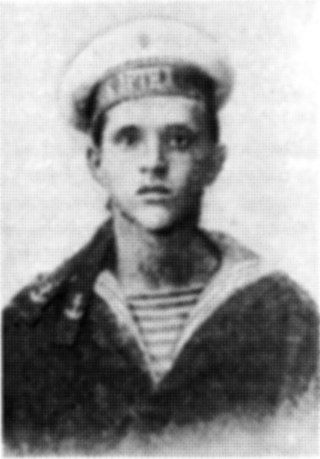Plot
While preparations were being made for the Fourth Regional Congress in Oleksandrivsk, [11] the local revolutionary committee met to discuss plans for a coup d'état. [12] The plot was headed by the pro-Bolshevik insurgent commander Yevgeny Polonsky, [13] who led the Insurgent Army's 3rd Crimean Regiment (later known as the Iron Regiment) and was a delegate to the upcoming Congress. [11]
Financed in part by a loan from the bourgeoisie of Oleksandrivsk, the committee planned to mobilize armed workers' detachments and have them join up with the Iron Regiment at its headquarters in Nikopol, seize the city and make it their centre of operations. [14] The committee recruited mutinous insurgents from former units of the Red Army, [15] and packed command posts of the Insurgent Army with members of the Communist Party of Ukraine (CPU), [16] even successfully electing one of their own members (P. Novitsky) to the Military Revolutionary Council (VRS) at the Oleksandrivsk Congress. [17] Polonsky also managed to get himself appointed as commander of the Nikopol Military District, but was removed from his post towards the end of October 1919, on charges of spreading Bolshevik propaganda. [18] Nevertheless, their subversive activity eventually resulted in CPU cells being established in almost every insurgent unit, with the exception of those commanded by Foma Kozhyn and Fedir Shchus. [19] The CPU, which by this time controlled the entire 3rd and 33rd Divisions, [20] justified the existence of their cells to the Kontrrazvedka by claiming that it was part of an attempt to reconcile the Insurgent Army with the Red Army, and to prevent conflict from breaking out between the two factions. [21]
By the end of November, the army had been beset by epidemic typhus, which eventually killed 35,000 insurgents. [22] In Nikopol, the centre of both the plot and the epidemic, the activities of the 2nd Azov Corps were limited by low morale, which provided the mutiny with more support. [23] When the Insurgent Army quit Oleksandrivsk, the conspirators followed the Makhnovist leadership to Katerynoslav, [24] where the CPU established another underground committee and began carrying out anti-Makhnovist agitation, in an attempt to demoralise the local insurgent garrison. [25] The garrison's commander, Lashkevich, confronted the local Bolsheviks and threatened to arrest them, demanding the dissolution of the cells in his own 13th Regiment. [26] But this was blocked by the VRS, which resolved to uphold freedom of association for the Bolsheviks. [23]

Despite the movements of the plot, the Iron Regiment's deputy commander quickly confessed to the insurgent staff and became a double agent for the Kontrrazvedka, which monitored the conspiracy for six weeks. The insurgent counterintelligence discovered that Polonsky had transferred to Katerynoslav in order to poison Nestor Makhno and other members of the insurgent high command, including those being treated for typhus. [22] The insurgent staff didn't believe that a coup was possible, as only 10% of the army consisted of former Red soldiers and only 1% were members of the CPU. They commissioned the Kontrrazvedka to investigate, which confirmed the existence of the conspiracy and assigned an agent to infiltrate it. [23]












